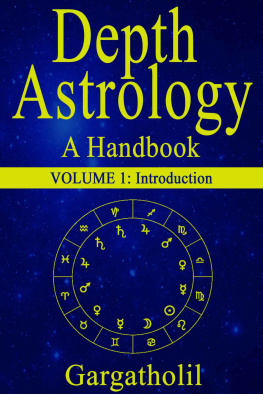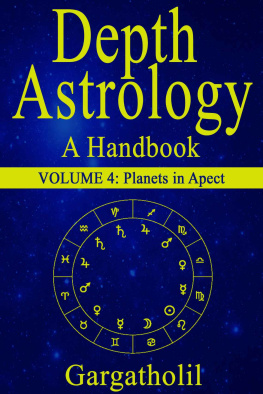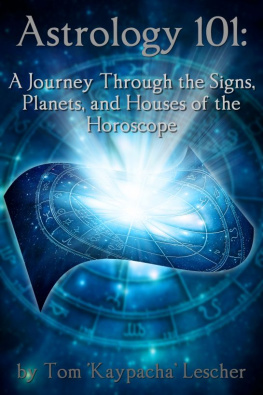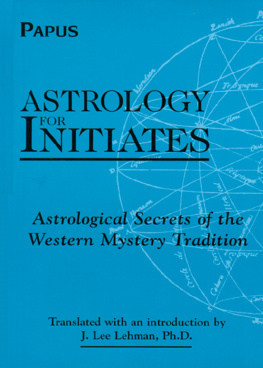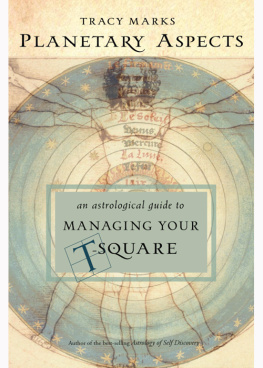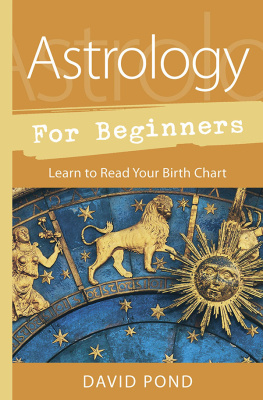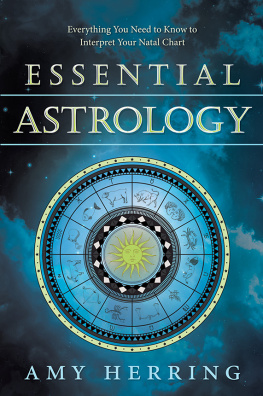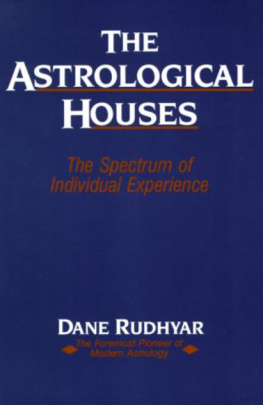DEPTH ASTROLOGY
An Astrological Handbook
Volume 1
Introduction
By
Gargatholil
Smashwords Edition, License Notes
This ebook is licensed for your personal enjoyment only. This ebook may not be re-sold or given away to other people. If you would like to share this book with another person, please purchase an additional copy for each recipient. If youre reading this book and did not purchase it, or it was not purchased for your use only, then please return to Smashwords.com and purchase your own copy. Thank you for respecting the hard work of this author.
Table of Contents
ACKNOWLEDGMENTS
I briefly wish to acknowledge the influences and contributions of several writers whom I have never met but who have shaped my thinking and informed my knowledge of depth astrology. These include Alan Leo for a general introduction to astrology in his Esoteric Astrology ; the great Dane Rudhyar, particularly for his work in the interpretation of the astrological houses; Liz Greene, especially for her work with Saturn; Frances Sakoian and Louis Aeker for their work on the quincunx; Stephen Arroyo; Donna Cunningham and more whom I have forgotten.
PREFACE
The natural horoscope is a mandala. The natural horoscope is also the complete astrological symbology of signs, houses, planets, points and aspects. As mandala, the center of the natural horoscope is, as all centers are, the One. From the One manifest the Twelve (the Zodiacal signs and houses). Each has its own center, which is its Essence.
The Essences of the Twelve are each a different (differentiated) reflection of the OneIts emanations. So, too, are the ten planets and the five points. Each of these Essences is differentiated from the One and from each other by their AttributesElements, Modalities (the three gunas of Hindu thought) and Qualities. These Attributes are then manifested on various planes, or levels of differentiation. It is this differentiation, on various levels, that result in the variety of qualities and functioning represented by the astrological symbols.
The more undifferentiated the manifestation of the astrological symbol, the purer is the expression of its Essence. Also, the more undifferentiated it is, the more the description of its Essence is ineffable. As the Attributes become more differentiated, they become more concrete and material. Also, the qualities symbolized by an astrological symbol are more strongly associated with the ego as the astrological symbol is actualized on planes of greater differentiation (lower levels of consciousness).
As the astrological symbols are manifested at levels of greater diversity and greater material content, the consciousness or spirituality associated with their attributes and qualities lessens. Multiplication of meaning is a movement away from Wholeness, away from Spiritual Oneness. At an outer ring of the astrological mandala, the qualities and attributes symbolized by the planets, signs, houses and aspects begin to contain tangible quantities of Emptiness. This Emptiness is the self-destructive polarity of the astrological mandala. It is born of attachment to the ego, which is illusion (i.e., the ego itself is an Emptiness).
Thus, the mandala becomes darker and darker as it moves away from the Light (which is the Center). The growing darkness is self-destruction or annihilation. In the end, all the astrological symbols manifest at the negative polar extreme in a self-destructive mode. Thus, ironically, there is a unity of meaning at both polarities of the astrological spectrumundifferentiated Oneness at the positive pole (or Center) and self-destruction at the negative pole.
In the chapters that follow, the astrological symbols found in the horoscope are analyzed consistent with the framework presented above. Before describing just how the analysis proceeds, I want to discuss the idea of the astrological symbol. Not long ago, with Dane Rudhyar and others, a more mature astrology developed in the Western worldan astrological school that I would label depth astrology. In this school, the old and erroneous ideasthat physical planets caused or influenced events in peoples lives through their motions and positioning in relation to the Zodiac, that the arrangement of planets in the natal horoscope determined who you were and what would happen to you, that the primary value of astrology was to predict the futurein short, all of the practices by which astrology had been duly labeled an unscientific superstitionwere abandoned to a great extent.
These outmoded ideas were replaced by an awareness that the physical relationships of the planets and Zodiacal signs in relation to the Earth were symbolic of psychological and archetypal forces acting within and through the personal psyche. These pioneers of depth astrology realized that the correspondences between the observed movements and placements of the planets, on the one hand, and the inner or outer circumstances that were being experienced, on the other hand, are synchronistic, and not causal, in nature.
Much of the writing about the meaning of the astrological symbology (in terms of personality, psychological and emotional forces, and self-development) has been influenced, directly or indirectly, by Jungian psychology. The analysis of the astrological symbols presented in this work is consistent with this approach.
There have also been, chiefly in reaction to the labeling of astrology as unscientific, some attempts to ground astrology in an objective, observation-based, scientific framework. While I have no quarrel with this approach, my own approach has been to deal with the astrological symbols as symbols. A symbol, as I have defined it, is a content-holder for an idea or a group of related ideas. As such, symbols can be manipulated and juxtaposed to derive meanings that are specific to the particular combination of symbols being considered.
The process of exploring the astrological symbol set is admittedly intellectual, intuitive and subjective. It is more art than science. Its validity rests on the Platonic idea that this consensual reality (i.e., the material world) is a copy of the Form of a Reality that exists in the world of Idea. As above, so below. If the astrological horoscope is a symbol-map deriving from a higher Reality, then an intuitive perception of the meaning of that map should be possible. This leads to an intellectual construct that, hopefully, represents a valid functionality.
Please note that I have claimed a valid functionality and not the valid functionality. One key idea that underpins the analysis of the astrological symbology presented in this work is that, while an Absolute may exist, this reality is relativistic. There is no correct point of view, only valid points of view. Thus, while the analysis presented here is not objective, I do believe that it is pragmatic. If a valid construct works, then it is valuable to the individual(s) for whom it is useful.
It is my hope that the analysis presented in this book works to enhance self-understanding and self-direction for those individuals attuned to it. You will hopefully enhance your understanding of others, as well. Particularly, I hope that this work is useful to a group of practicing astrologers.
INTRODUCTION
The basic format used in this work is to juxtapose the astrological symbols from two symbol sets and explore the meaning derived from this juxtaposition. The sets used are the planets and major points (from here on, simply planets), the signs and the houses. A juxtaposition of more than two becomes too cumbersome, both in terms of simplicity and the number of permutations. Of course, in actual chart interpretation, the astrologer must consider multiple juxtapositions and deal with these intuitively. The book explores meanings for two juxtaposed sets in hopes of aiding the interpretation of the multiple juxtapositions that are actually found in the horoscope.

